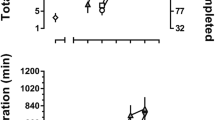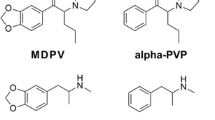Abstract
Rationale
3,4-Methylenedioxypyrovalerone (MDPV) and 3,4-methylenedioxy-N-methylcathinone (methylone) are synthetic drugs found in so-called “bath salts” products. Both drugs exert their effects by interacting with monoamine transporter proteins. MDPV is a potent uptake blocker at transporters for dopamine and norepinephrine while methylone is a non-selective releaser at transporters for dopamine, norepinephrine, and serotonin (5-HT).
Objectives
We hypothesized that prominent 5-HT-releasing actions of methylone would render this drug less reinforcing than MDPV.
Methods
To test this hypothesis, we compared behavioral effects of MDPV and methylone using intravenous (i.v.) self-administration on a fixed-ratio 1 schedule in male rats. Additionally, neurochemical effects of the drugs were examined using in vivo microdialysis in nucleus accumbens, in a separate cohort of rats.
Results
MDPV self-administration (0.03 mg/kg/inj) was acquired rapidly and reached 40 infusions per session, similar to the effects of cocaine (0.5 mg/kg/inj), by the end of training. In contrast, methylone self-administration (0.3 and 0.5 mg/kg/inj) was acquired slowly, and response rates only reached 20 infusions per session by the end of training. In dose substitution studies, MDPV and cocaine displayed typical inverted U-shaped dose-effect functions, but methylone did not. In vivo microdialysis revealed that i.v. MDPV (0.1 and 0.3 mg/kg) increased extracellular dopamine while i.v. methylone (1 and 3 mg/kg) increased extracellular dopamine and 5-HT.
Conclusions
Our findings support the hypothesis that elevations in extracellular 5-HT in the brain can dampen positive reinforcing effects of cathinone-type drugs. Nevertheless, MDPV and methylone are both self-administered by rats, suggesting these drugs possess significant abuse liability in humans.





Similar content being viewed by others
References
Aarde SM, Huang PK, Creehan KM, Dickerson TJ, Taffe MA (2013) The novel recreational drug 3,4-methylenedioxypyrovalerone (MDPV) is a potent psychomotor stimulant: self-administration and locomotor activity in rats. Neuropharmacology 71:130–40
Aarde SM, Huang PK, Dickerson TJ, Taffe MA (2015) Binge-like acquisition of 3,4-methylenedioxypyrovalerone (MDPV) self-administration and wheel activity in rats. Psychopharmacology (Berl) 232:1867–77
Bauer CT, Banks ML, Blough BE, Negus SS (2013) Use of intracranial self-stimulation to evaluate abuse-related and abuse-limiting effects of monoamine releasers in rats. Br J Pharmacol 168:850–62
Baumann MH (2014) Awash in a sea of ‘bath salts’: implications for biomedical research and public health. Addiction 109:1577–9
Baumann MH, Clark RD, Rothman RB (2008) Locomotor stimulation produced by 3,4-methylenedioxymethamphetamine (MDMA) is correlated with dialysate levels of serotonin and dopamine in rat brain. Pharmacol Biochem Behav 90:208–17
Baumann MH, Clark RD, Woolverton WL, Wee S, Blough BE, Rothman RB (2011) In vivo effects of amphetamine analogs reveal evidence for serotonergic inhibition of mesolimbic dopamine transmission in the rat. J Pharmacol Exp Ther 337:218–25
Baumann MH, Ayestas MA Jr, Partilla JS, Sink JR, Shulgin AT, Daley PF, Brandt SD, Rothman RB, Ruoho AE, Cozzi NV (2012) The designer methcathinone analogs, mephedrone and methylone, are substrates for monoamine transporters in brain tissue. Neuropsychopharmacology 37:1192–203
Baumann MH, Partilla JS, Lehner KR, Thorndike EB, Hoffman AF, Holy M, Rothman RB, Goldberg SR, Lupica CR, Sitte HH, Brandt SD, Tella SR, Cozzi NV, Schindler CW (2013) Powerful cocaine-like actions of 3,4-methylenedioxypyrovalerone (MDPV), a principal constituent of psychoactive ‘bath salts’ products. Neuropsychopharmacology 38:552–62
Bonano JS, Glennon RA, De Felice LJ, Banks ML, Negus SS (2014) Abuse-related and abuse-limiting effects of methcathinone and the synthetic “bath salts” cathinone analogs methylenedioxypyrovalerone (MDPV), methylone and mephedrone on intracranial self-stimulation in rats. Psychopharmacology (Berl) 231:199–207
Bradbury S, Bird J, Colussi-Mas J, Mueller M, Ricaurte G, Schenk S (2014) Acquisition of MDMA self-administration: pharmacokinetic factors and MDMA-induced serotonin release. Addict Biol 19:874–84
Cameron KN, Kolanos R, Solis E Jr, Glennon RA, De Felice LJ (2013) Bath salts components mephedrone and methylenedioxypyrovalerone (MDPV) act synergistically at the human dopamine transporter. Br J Pharmacol 168:1750–7
Creehan KM, Vandewater SA, Taffe MA (2015) Intravenous self-administration of mephedrone, methylone and MDMA in female rats. Neuropharmacology 92:90–7
De La Garza R 2nd, Fabrizio KR, Gupta A (2007) Relevance of rodent models of intravenous MDMA self-administration to human MDMA consumption patterns. Psychopharmacology (Berl) 189:425–34
Drug Enforcement Administration (2011) Schedules of controlled substances: temporary placement of three synthetic cathinones in schedule I. Final order. Fed Regist 76:65371–65375
Drug Enforcement Administration (2013) Establishment of drug codes for 26 substances. Final rule. Fed Regist 78:664–666
Drug Enforcement Administration (2014) National Forensic Laboratory Information System Special Report: Synthetic Cannabinoids and Synthetic Cathinones Reported in NFLIS, 2010–2013. U.S. Drug Enforcement Administration, Springfield, VA URL: https://www.nflis.deadiversion.usdoj.gov/DesktopModules/ReportDownloads/Reports/NFLIS_SR_CathCan_508.pdf
Eshleman AJ, Wolfrum KM, Hatfield MG, Johnson RA, Murphy KV, Janowsky A (2013) Substituted methcathinones differ in transporter and receptor interactions. Biochem Pharmacol 85:1803–15
Fantegrossi WE, Gannon BM, Zimmerman SM, Rice KC (2013) In vivo effects of abused ‘bath salt’ constituent 3,4-methylenedioxypyrovalerone (MDPV) in mice: drug discrimination, thermoregulation, and locomotor activity. Neuropsychopharmacology 38:563–73
Gatch MB, Taylor CM, Forster MJ (2013) Locomotor stimulant and discriminative stimulus effects of ‘bath salt’ cathinones. Behav Pharmacol 24:437–47
German CL, Fleckenstein AE, Hanson GR (2014) Bath salts and synthetic cathinones: an emerging designer drug phenomenon. Life Sci 97:2–8
Johnson PS, Johnson MW (2014) Investigation of “bath salts” use patterns within an online sample of users in the United States. J Psychoactive Drugs 46:369–78
Karlsson L, Andersson M, Kronstrand R, Kugelberg FC (2014) Mephedrone, methylone and 3,4-methylenedioxypyrovalerone (MDPV) induce conditioned place preference in mice. Basic Clin Pharmacol Toxicol 115:411–416
Kehr J, Ichinose F, Yoshitake S, Goiny M, Sievertsson T, Nyberg F, Yoshitake T (2011) Mephedrone, compared with MDMA (ecstasy) and amphetamine, rapidly increases both dopamine and 5-HT levels in nucleus accumbens of awake rats. Br J Pharmacol 164:1949–58
Kesha K, Boggs CL, Ripple MG, Allan CH, Levine B, Jufer-Phipps R, Doyon S, Chi P, Fowler DR (2013) Methylenedioxypyrovalerone (“bath salts”), related death: case report and review of the literature. J Forensic Sci 58:1654–9
Kiyatkin EA, Kim AH, Wakabayashi KT, Baumann MH, Shaham Y (2015) Effects of social interaction and warm ambient temperature on brain hyperthermia induced by the designer drugs methylone and MDPV. Neuropsychopharmacology 40:436–45
Lopez-Arnau R, Martinez-Clemente J, Pubill D, Escubedo E, Camarasa J (2012) Comparative neuropharmacology of three psychostimulant cathinone derivatives: butylone, mephedrone and methylone. Br J Pharmacol 167:407–20
Lopez-Arnau R, Martinez-Clemente J, Abad S, Pubill D, Camarasa J, Escubedo E (2014a) Repeated doses of methylone, a new drug of abuse, induce changes in serotonin and dopamine systems in the mouse. Psychopharmacology (Berl) 231:3119–29
Lopez-Arnau R, Martinez-Clemente J, Pubill D, Escubedo E, Camarasa J (2014b) Serotonergic impairment and memory deficits in adolescent rats after binge exposure of methylone. J Psychopharmacol 28:1053–63
Marusich JA, Grant KR, Blough BE, Wiley JL (2012) Effects of synthetic cathinones contained in “bath salts” on motor behavior and a functional observational battery in mice. Neurotoxicology 33:1305–13
Panlilio LV, Katz JL, Pickens RW, Schindler CW (2003) Variability of drug self-administration in rats. Psychopharmacology (Berl) 167:9–19
Schenk S, Hely L, Lake B, Daniela E, Gittings D, Mash DC (2007) MDMA self-administration in rats: acquisition, progressive ratio responding and serotonin transporter binding. Eur J Neurosci 26:3229–36
Schindler CW, Cogan ES, Thorndike EB, Panlilio LV (2011) Rapid delivery of cocaine facilitates acquisition of self-administration in rats: an effect masked by paired stimuli. Pharmacol Biochem Behav 99:301–6
Seely KA, Patton AL, Moran CL, Womack ML, Prather PL, Fantegrossi WE, Radominska-Pandya A, Endres GW, Channell KB, Smith NH, McCain KR, James LP, Moran JH (2013) Forensic investigation of K2, Spice, and “bath salt” commercial preparations: a three-year study of new designer drug products containing synthetic cannabinoid, stimulant, and hallucinogenic compounds. Forensic Sci Int 233:416–22
Simmler LD, Buser TA, Donzelli M, Schramm Y, Dieu LH, Huwyler J, Chaboz S, Hoener MC, Liechti ME (2013) Pharmacological characterization of designer cathinones in vitro. Br J Pharmacol 168:458–70
Watterson LR, Hood L, Sewalia K, Tomek SE, Yahn S, Johnson CT, Wegner S, Blough BE, Marusich JA, Olive MF (2012) The reinforcing and rewarding effects of methylone, a synthetic cathinone commonly found in “bath salts”. J Addict Res Ther S9:002
Watterson LR, Kufahl PR, Nemirovsky NE, Sewalia K, Grabenauer M, Thomas BF, Marusich JA, Wegner S, Olive MF (2014) Potent rewarding and reinforcing effects of the synthetic cathinone 3,4-methylenedioxypyrovalerone (MDPV). Addict Biol 19:165–74
Wee S, Woolverton WL (2006) Self-administration of mixtures of fenfluramine and amphetamine by rhesus monkeys. Pharmacol Biochem Behav 84:337–43
World Health Organization (2015). WHO expert committee on drug dependence: thirty-sixth report. WHO Technical Report Series no. 991. Geneva, Switzerland . URL: http://apps.who.int/iris/bitstream/10665/153834/1/WHO_TRS_991_eng.pdf?ua=1
Wright MJ Jr, Angrish D, Aarde SM, Barlow DJ, Buczynski MW, Creehan KM, Vandewater SA, Parsons LH, Houseknecht KL, Dickerson TJ, Taffe MA (2012) Effect of ambient temperature on the thermoregulatory and locomotor stimulant effects of 4-methylmethcathinone in Wistar and Sprague-Dawley rats. PLoS One 7:e44652
Wright TH, Cline-Parhamovich K, Lajoie D, Parsons L, Dunn M, Ferslew KE (2013) Deaths involving methylenedioxypyrovalerone (MDPV) in Upper East Tennessee. J Forensic Sci 58:1558–62
Zolkowska D, Jain R, Rothman RB, Partilla JS, Roth BL, Setola V, Prisinzano TE, Baumann MH (2009) Evidence for the involvement of dopamine transporters in behavioral stimulant effects of modafinil. J Pharmacol Exp Ther 329:738–46
Acknowledgments
This research was supported by the Intramural Research Program of NIH, NIDA. The authors have no conflicts of interest to report. We dedicate this paper to our colleague and friend Steven R. Goldberg who passed away suddenly on November 25, 2014.
Author information
Authors and Affiliations
Corresponding author
Rights and permissions
About this article
Cite this article
Schindler, C.W., Thorndike, E.B., Goldberg, S.R. et al. Reinforcing and neurochemical effects of the “bath salts” constituents 3,4-methylenedioxypyrovalerone (MDPV) and 3,4-methylenedioxy-N-methylcathinone (methylone) in male rats. Psychopharmacology 233, 1981–1990 (2016). https://doi.org/10.1007/s00213-015-4057-0
Received:
Accepted:
Published:
Issue Date:
DOI: https://doi.org/10.1007/s00213-015-4057-0




